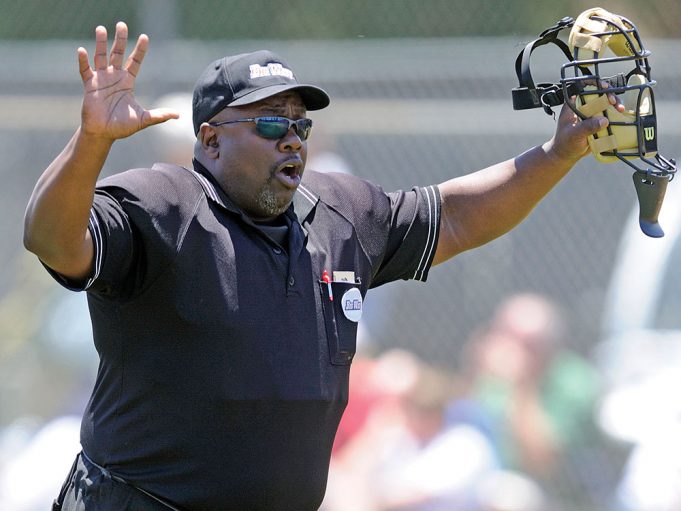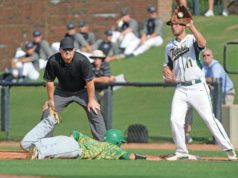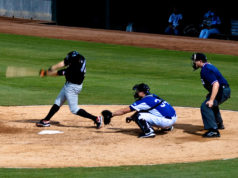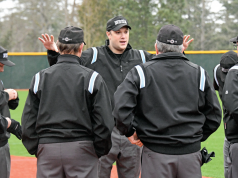Most baseball games are routine in terms of the calls the umpires must make. We know the plate umpire has to call balls and strikes and there is likely to be an opportunity for a base umpire to help out on a checked swing. There have to be some safe/out calls for the base umpires as no game has ever been played with all the batters on both teams whiffing. A game without a contentious fair/foul call is rare. So the challenge for umpires takes place when something out of the ordinary occurs.
In many cases, the situation that makes an umpire think twice is either interference or obstruction. Here are some of the situations where umpires need to be sure whether to call ”time” and stop play or whether to allow play to progress.
Umpire hit by batted ball. If a fair ball touches an umpire in fair territory before touching an infielder, it is interference and the batter is awarded first base. The ball is dead and other runners advance only if forced. However, if a fair ball touches an umpire after having passed an infielder other than the pitcher, or after having touched an infielder, including the pitcher, the ball remains live and in play (NFHS 5-1-1f1; NCAA 6-1h, 6-2f Nt, 8-2f; pro 6.01a11).
Obstruction. NFHS rules make the umpire’s life a bit easier because all obstruction is a delayed dead ball and play is allowed to continue until all action ends. In NCAA and pro play, however, if the obstructed runner is being played on, the ball is immediately dead and the play is stopped (NFHS 5-1-2b; NCAA 2-55, 6-3c, 6-3d; pro 6.01h).
Situations where obstruction may occur while the runner is being played on include: rundowns; any play where another fielder is making a direct throw to a base in an attempt to retire that runner; and a batter-runner who has not yet reached first base and a ball is hit to an infielder.
Play 1: With one out and R2 on second and R3 on third, B1 flies out to center field. Both runners legally tag up. R3 stumbles going to the plate and ends up in a rundown. R2 is between second and third when R3 is obstructed by F5 during the rundown. Ruling 1: In NCAA and pro, the ball becomes dead the moment R3 is obstructed because he was being played on. R3 is awarded home — one base beyond his last legally touched base prior to the obstruction. R2 is entitled to the base he would have reached had there been no obstruction. In NFHS, the play is kept live until all action ceases.
Dropped third strike. After an uncaught third strike, the batter may not interfere with the catcher’s fielding or throwing by stepping out of the batter’s box or making any other movement that hinders the catcher’s play. If while attempting to advance to first base, the batter-runner intentionally deflects the ball, the batter-runner is declared out, the ball is dead and all runners return.
If the batter unintentionally deflects the ball, the ball is live and in play. NCAA rules further specify that if there are less than two outs and first base is occupied, the ball is dead and all runners return, unless the runner(s) are stealing on the pitch (NFHS 7-3-5b, 8-4-1a; NCAA 7-11f, 7-11h Nt; pro 6.01a1).
Play 2: With no runners, B1 swings and misses at a pitch in the dirt for strike three. F2 blocks the ball, which then rolls forward. As B1 leaves the batter’s box, he kicks the ball into foul territory. B1 is safe at first. Ruling 2: The umpire must judge whether B1 intentionally kicked the ball. If so, B1 is out for hindering F2’s attempt to field the ball; the ball is dead. If not, the play stands.
Spectator interference. When someone other than one of the nine defensive players touches a live ball, the umpires must first determine whether that person was a spectator or an “authorized” person. Only NCAA and pro rules formally make that distinction. Nonetheless, non-playing personnel such as coaches in uniform, athletic trainers, umpires, team managers, bat persons and authorized home attendants, including security personnel, are only guilty of interference if their act is intentional (NFHS 2-21-3, 5.1.1K; NCAA 4-7; pro 6.01d, e). If such personnel inadvertently touch the ball or their contact with a player does not alter the play, the ball remains live and in play. Please note it is intentional interference if any non-player fields, kicks or pushes a ball, regardless of possible motives.
For unintentional contact, the ball is live and in play. It is unintentional “interference” if a base coach, bat person, etc., tries to evade the ball and it touches the individual or if it touches such person without the person being aware the ball was coming or if the ball hits an animal. If the umpire determines the interference was intentional based on the person’s action, the play is treated the same as spectator interference.
Follow-through interference. Follow-through interference is when the bat hits the catcher after the batter has swung at a pitch and hinders actions at home plate or the catcher’s attempt to play on a runner (2-21-4). The batter is entitled to swing at any pitch unhindered by the catcher, but once he does he is responsible for not interfering with any attempt by the catcher to make a defensive play. The follow through is the batter’s responsibility, so if the bat hits the catcher on the follow through, it’s the batter’s fault unless the catcher jumps up and moves into the swing.
The key for umpires is determining if a play is in progress. If there is not a play occuring when the contact occurs, there cannot be interference. The pitch is called a strike, the ball is dead and no runner shall advance on the play. If there are two strikes on the batter and the follow-through causes an uncaught third strike, the batter is out and no runners can advance (NFHS 7-3-5c; NCAA 6-2d1; pro 6.03a3 Cmt, MiLBUM 7.14). If the contact occurs while the catcher is in the act of making a throw to retire a runner, the codes differ. In NFHS, the batter is out and the runner returns. In NCAA and pro, time is called at the end of playing action, the batter is only out on a third strike and runners return (unless the catcher’s initial throw retires the runner) (NFHS 7-3-5c; NCAA 6-2d2; pro 6.03a3 Cmt, PBUC 7.14).
Play 3: With a R1 on first and a 1-0 count, B1 swings and misses the pitch. His follow-through on the swing comes around and hits the ball out of F2’s glove immediately after he securely catches the pitch. R1 then goes safely into second base. Ruling 3: In NFHS, B1 is out and R1 returns to first base. Under NCAA and pro rules, a strike is called on B1 and R1 returns to first base.
What's Your Call? Leave a Comment:
Note: This article is archival in nature. Rules, interpretations, mechanics, philosophies and other information may or may not be correct for the current year.
This article is the copyright of ©Referee Enterprises, Inc., and may not be republished in whole or in part online, in print or in any capacity without expressed written permission from Referee. The article is made available for educational use by individuals.


















